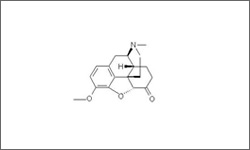Hydrocodone

Hydrocodone can be given as a tablet or liquid, usually several times daily. Hydrocodone is available in several forms in combination with other drugs. These include: Lortab® (with acetaminophen), Maxidone® (with acetaminophen), Norco® (with acetaminophen), Vicodin® (with acetaminophen), Vicoprofen® (with ibuprofen), Zydone® (with acetaminophen).1
- 1 Hydrocodone. MedlinePlus. https://medlineplus.gov/druginfo/meds/a614045.html
Hydrocodone is a semisynthetic opiate that has properties similar to those of codeine. It binds primarily to the mu opioid receptor to relieve pain.1
The diagram below shows the 3D molecular structure of hydrocodone.
- 1 Hydrocodone. MedlinePlus. https://medlineplus.gov/druginfo/meds/a614045.html
Common side effects include: stomach pain, dry mouth, tiredness, headache and back pain.1 Hydrocodone can be habit-forming. Psychological and physiological withdrawal symptoms can occur if the patient becomes drug-dependent. With prolonged use, tolerance may also become a problem, requiring higher dosages to achieve pain relief. Alcohol can intensify some of the mental and emotional side effects of hydrocodone, such as drowsiness and changes in mood. Patients should avoid alcohol consumption while taking hydrocodone. At higher doses hydrocodone can cause respiratory depression. This may result in a potentially dangerous slowing of a patient's breathing rate.2
